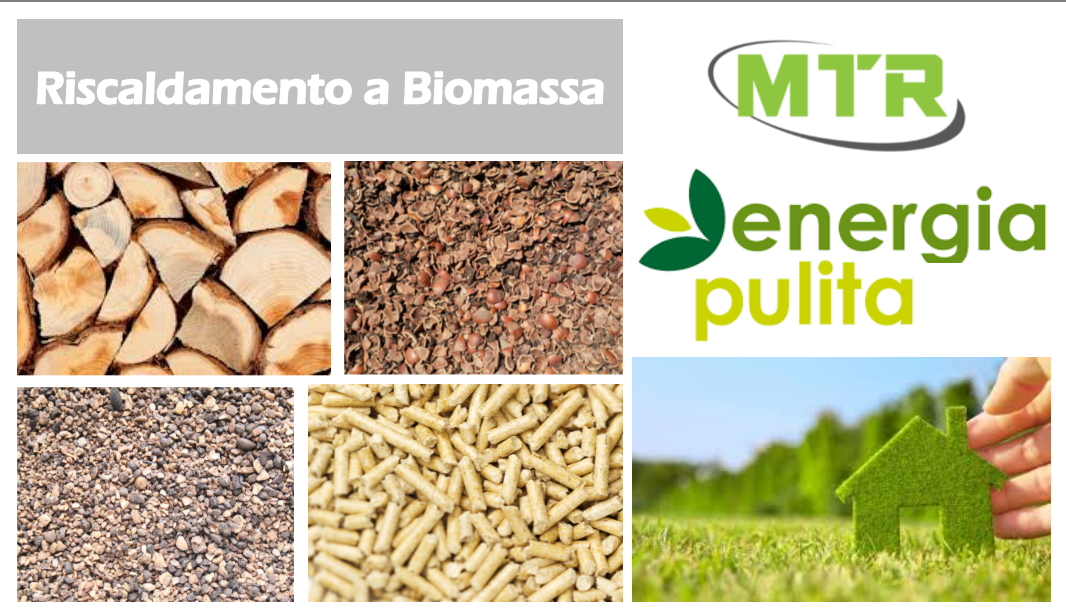- Via dell'industria 5, Castel d'Ario (MN) Italy
- export@mtrcaldaie.com
- +39 0376 150 5872
- +39 0376 150 5872
Biomass Heating

The economic crisis that has marked the last few years , has led to revaluate and choose more biomass as a source of heating.
Choose a biomass system also means choosing a renewable energy resource and environmentally friendly.
Biomass is defined as the organic matter of vegetable or animal origin including the biodegradable fraction of products and residues from agriculture , forestry residues , waste from wood processing industry (chips, sawdust, etc. . ) As well as the biodegradable municipal waste. Among the renewable energy sources, biomass can be used , either directly or through conversion processes such as biofuel for the production of heat or electricity.
Biomass is plant matter that makes up the plants. The energy contained in it is stored solar energy during the growth by means of photosynthesis. For this reason, biomass, if used within a continuous cycle of production-use, they are a renewable energy resource and environmentally friendly. Burning gas or oil to warm up moves and accumulates in the atmosphere carbon removed from the soil , thus contributing to the greenhouse effect. Conversely, the combustion of biomass does not give any net contribution to the greenhouse effect, because the carbon that is released by burning the wood comes from the atmosphere itself and not from the ground.
WOOD : CLEAN ENERGY
The wood is considered to be among the best sources of clean energy, as it is RENEWABLE, NEUTRAL and ECO.
- RENEWABLE: is repeated indefinitely by growing trees. The wood used today for heating comes almost entirely from dedicated plantations. Cutting down trees in a responsible manner will provide more living space to the forest, ensuring a healthy regeneration of vegetation.
- NEUTRAL: regarding the emission of carbon dioxide in the atmosphere , the CO2 emitted by combustion is the same as a few years before had been absorbed by photosynthesis .
- GREEN: because at the end of the combustion process are only natural substances already present in the environment. In contrast to fossil fuels (coal, oil, gas) that contribute to the greenhouse effect, the wood burned correctly, it is environmentally friendly .
PELLETS : FUEL NATURAL
The pellet is a fuel with important advantages, as it is ECO-FRIENDLY, CONVENIENT and with a HIGH CALORIFIC VALUE.
- ECO: is obtained by pressing , without adding any glue or other similar items , sawdust or sawmill waste , or industrial wood .
- PRACTICAL: is supplied in bags for easy maneuverability. Just pour it in the appropriate tanks boilers designed to use this type of fuel. The residue of ash in the brazier is very reduced.
- HIGH CALORIFIC VALUE: the low percentage of moisture units to large density leading to high thermal efficiency , that depending on the composition of the pellets , can reach up to 5 KW/h per Kg
THE BIOMASS BOILERS
Currently, modern biomass boilers are able to replace the classical gas boilers, due to the increased efficiency of the plants ( 80-89 %).
For all types of biomass boiler apply some general considerations :
- It is necessary to have spaces a little ' more extensive than those required by traditional systems , in addition to the placement of the boiler also for the storage of the fuel ;
- The boiler room must be spacious and well-ventilated and should be able to accommodate the heat accumulator , the boiler for hot water , the electrical and hydraulic systems .
- The flue must be efficient and allow for the removal and dispersal of smoke , but also ensure , through an adequate draft , the smooth operation of the boiler.
The wood-fired boilers are the most innovative reverse flame boilers , so defined because the combustion chamber is located below the cargo area of the wood .
While for boilers pieces of firewood , fuel loading is done manually , in case of pellet boilers , biofuel can also be loaded automatically by means of special mechanical devices that allow the handling from the place of storage to the boiler.
CHOICE AND FUEL SYSTEM TIMBER
The main types of boilers for small and medium-sized utilities, currently available on the market are designed to burn three categories of biofuels :
1. Firewood logs ;
2 . Pellets;
3 . Granular biofuel (corn, peanut residue oil, or shells of various fruits , such as hazelnuts , pistachios, almonds , pine nuts ... ) .
The burning of firewood is still the most prevalent form of biomass use for home heating , although in biofuels, pellets have a higher energy content and a more uniform and constant size , which make them easier to manage and transport . As regards the use of wood , one should prefer the one with a moisture content not exceeding 20% , the value obtained with an adequate seasoning , that allows to reduce the formation of corrosive condensates and smokiness .
The size of the boiler must be made after careful consideration of the characteristics of the building and the climate in which it is located. The presence of a buffer tank allows to considerably increase the autonomy , especially in periods less cold , in that the energy developed by the boiler in a limited period of time is accumulated and redistributed to the heating during the day. This buffering effect of the accumulator is greater the inertial larger the size of the accumulator itself.


